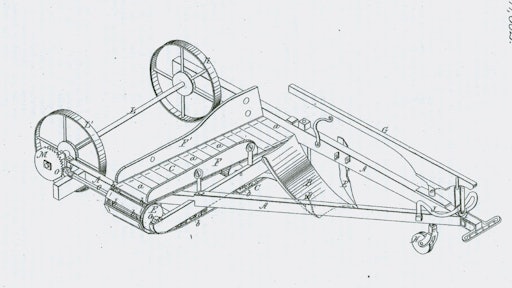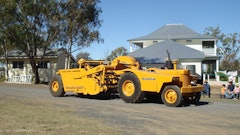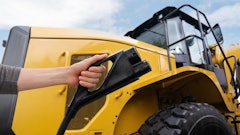
With the new year, we will begin a new series uncovering the history of loaders, from their origins to the most modern-day machines.
As we saw in our recent coverage of the first elevating scraper, haulers are fine for hauling and dumping; but loading them was the challenge. In the early 1850s, there were only two ways to do it: a steam shovel, or hand shoveling. That began to change when, on July 25, 1854, John Lyon of Harrisburg, Iowa, was issued U. S. Patent 11382 for a “Ditching Plow.”
This little machine was the earliest known elevating grader. The term “elevating grader” was a bit of a misnomer, as an elevating grader didn’t actually “grade” as in leveling in the sense of a pull grader. Rather, it was a digging machine.
Pulled and pushed by stock, Lyon’s design revolutionized excavation and loading of suitable bank materials. It couldn’t be used in hard or rocky material that would damage the machine or tear the belt; cohesive material would clog it, and large chunks tended to tumble back down the belt.
Rather than digging and dumping a shovelful or bucketful at a time, it was designed for continuous loading. This was achieved by two components: a cutting edge that was forced into the bank at grade or below for roadside ditching, and a cross-mounted conveyor. The forward motion of the loader provided the power; it forced the edge to dig, and a chain from the rear axle powered the conveyor.
The cutting-edge sheared material from the bank and guided it onto the conveyor, which lifted (or “elevated”) the spoil to dump opposite the cut into a wagon moving alongside. When the wagon was full, the loader stopped, the wagon pulled clear, and another took its place. The loader could also simply cast to form a windrow, in a process that came to be known as turnpiking. At the end of the cut, the loader would be turned around to work back on the other side of the right of way; some photos show an elevating grader working an inward spiral to cut grade for a large round storage tank.
These machines came into widespread use for their sheer efficiency compared to a steam excavator, especially in shallow working, and their basic design principles carried through to the gigantic Holland loaders that were developed in the 1970s. In the next issue, we’ll learn about some of the engineering features and issues of more advanced elevating graders.
Thomas Berry is an archivist and editor with the Historical Construction Equipment Association (HCEA).


























